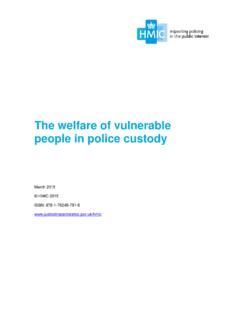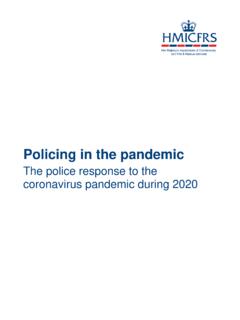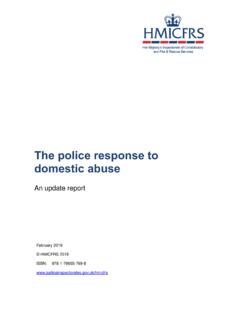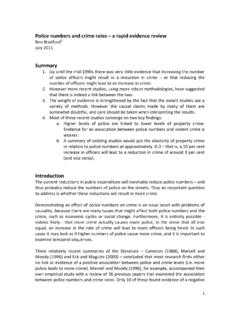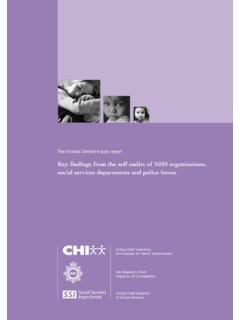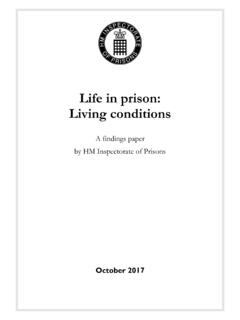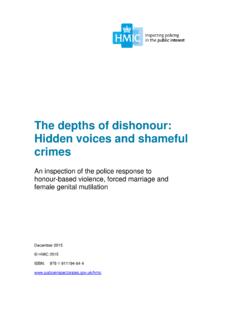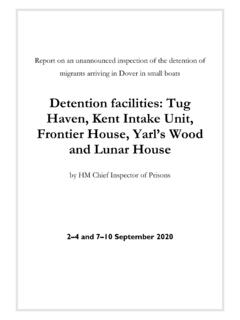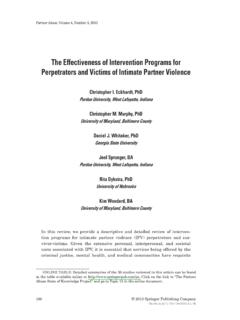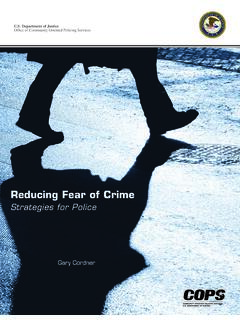Transcription of The effectiveness of visible police patrol The effect of ...
1 The effectiveness of visible police patrol Research into public expectations of policing in the UK has previously highlighted a strong preference for a highly visible police presence (Bradley 1998). However, when these views were explored in more detail, it was discovered that people's seemingly instinctive reaction to call for more bobbies on the beat' was motivated by a desire to see crime reduced. The study also suggested that the police can help ensure the public accept and support the targeting of resources in high priority areas by engaging them in a dialogue (for more evidence on community engagement in policing see Myhill 2006).
2 The effect of police patrol on crime and public perceptions Reviews of the best evidence of what works' in policing to reduce crime have highlighted that visible police patrol can reduce crime, but only if it is specifically targeted to crime hotspots (high crime locations) (Sherman and Eck 2002; Weisburd and Eck 2004). One trial1, carried out in the Minneapolis police Department, tested the impact of directed police patrols in crime hotspots at hot times' (Sherman and Weisburd 1995). Over a ten-month period, 55 experimental hotspots received twice as much police patrol as a similar number of control hotspots.
3 The study found that crime and disorder reduced significantly in the experimental hotspots compared with the control areas. One of the barriers to implementing directed patrol in the past has been the traditional view that targeting crime hotspots can simply result in the problem moving elsewhere (this is called crime displacement'). Importantly, recent evidence has concluded that crime displacement tends not to happen with focused police activity in high-crime places, and that the crime reduction benefits may even spread to the areas immediately surrounding the targeted locations (referred to in the literature as diffusion of benefits') (Bowers et al.)
4 2011). There is also robust evidence to suggest that targeted patrol particularly targeted foot patrol can have a positive impact on public perceptions (for a review of the evidence see Dalgleish and Myhill 2004). The evaluation of the National Reassurance Policing Programme, which tested the impact of neighbourhood teams, has shown that targeted foot patrol can improve public confidence in the police , perceptions of crime, and feelings of safety as well as reducing crime when implemented alongside community engagement and problem-solving (Tuffin et al 2006). Importantly, foot patrol was used by the police to initiate positive, informal contact with members of the public and in response to local priorities.
5 The visible presence of an officer patrolling on foot may also act as a control signal' a sign that the authorities are taking the problems of local people seriously (Innes 2004). Evidence from a follow-up evaluation has highlighted that, while targeted foot patrol may be a necessary ingredient to improve public 1. This was a randomised controlled trial': an experiment which compares results from a control group and a treatment group (following the method used in medical drugs trials) which enables causal statements to be made about the impact of an intervention. It uses random allocation of people or places to each group which reduces potential bias.
6 1. confidence, it may not be enough on its own without community engagement and problem-solving to have an effect (Quinton and Morris 2008). Random or reactive patrols that is, officers patrolling an area without concentrating on crime or anti-social behaviour hotspots, or simply being en route between attending calls from the public have been shown to have no crime reduction effect (Sherman and Eck 2002; Weisburd and Eck 2004). An evaluation carried out in Kansas City compared one area in which random general patrol was increased overall to other areas where patrols continued as usual or only in relation to calls for service.
7 It found random patrol had no effect on crime, disorder or fear of crime (Kelling et al. 1974). The evidence specifically on random foot patrol has similarly shown that it has no effect on crime rates ( police Foundation 1981). If patrols targeted on areas where crime is concentrated are most likely to be effective, what should officers do when they are in a crime hotspot? A recent US. study randomly assigned 83 hotspots of street violence to receive either problem- solving, high intensity foot patrol or the standard police response (Taylor et al, 2011). During the 90-day intervention period, the intensive patrol hotspots showed larger initial reductions in violence.
8 However, the effect was not sustained, and crime returned to its previous level in the 90-day follow-up period when the intervention was withdrawn. In comparison, while problem-solving took slightly longer to have an effect , its impact on violent crime was greater and longer lasting with evidence of sustained crime reduction during the 90-day follow-up period. This pattern of results suggests that a combined approach could be an effective strategy: using targeted foot patrol to bring crime down initially alongside problem-solving to have a more lasting impact. References Bowers, K., Johnson, S., Guerette, R.
9 , Summers, L. and Poynton, S. (2011). Do Geographically Focussed police Initiatives Displace Crime or Diffuse Benefits? A. Systematic Review. Journal of Experimental Criminology, 7 (4): 347-374. Bradley, R. (1998) Public Expectations and Perceptions of Policing. London: Home Office. Dalgleish, D. and Myhill, A. (2004) Reassuring the Public: A Review of International Policing Interventions. London: Home Office. Innes, M. (2004) Signal Crimes and Signal Disorders: Notes on Deviance as Communicative Action'. British Journal of Sociology, 55 (3): 335-55. Kelling, G., Pate, A., Dieckman, D. and Brown. C. (1974) The Kansas City Preventive patrol Experiment: Technical Report.
10 Washington, DC: police Foundation. Myhill, A. (2006) Community Engagement in Policing: Lessons from the literature. London: Home Office. police Foundation (1981) The Newark Foot patrol Experiment. Washington, DC: police Foundation. 2. Quinton, P. and Morris, J. (2008) Neighbourhood Policing: The Impact of Piloting and Early National Implementation. London: Home Office. Sherman, L. and Eck, J. (2002) police for Crime Prevention, in: Sherman, L., Farrington, D., Welsh, B. and Layton MacKenzie, D. (eds) Evidence-Based Crime Prevention. London: Routledge. Sherman, L. and Weisburd, D. (1995). General Deterrent Effects of police patrol in Crime Hotspots: A Randomized Controlled Trial.


